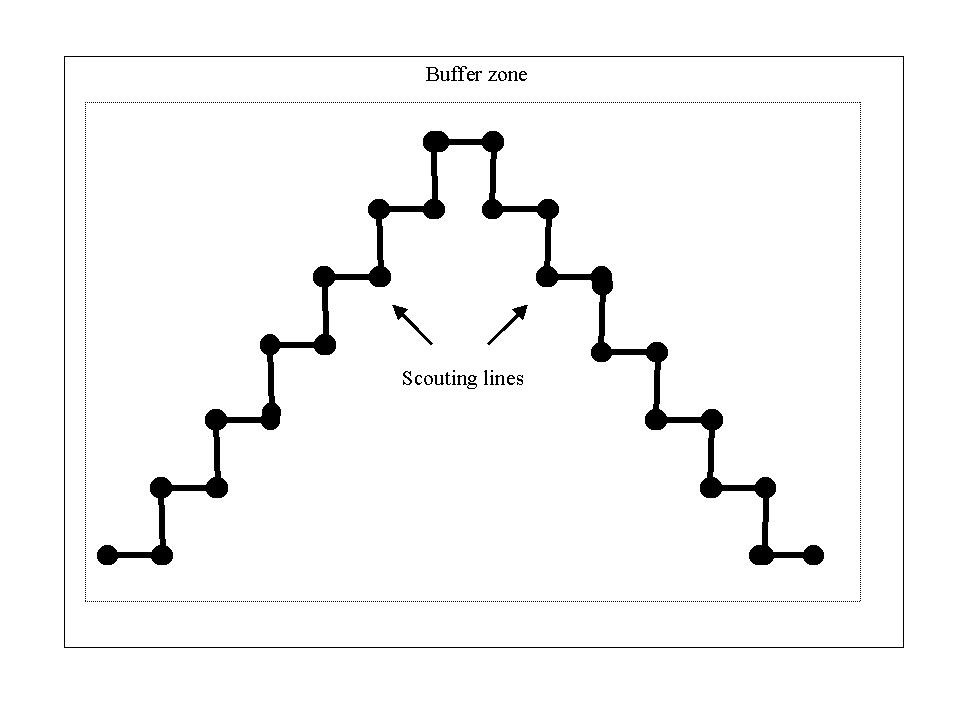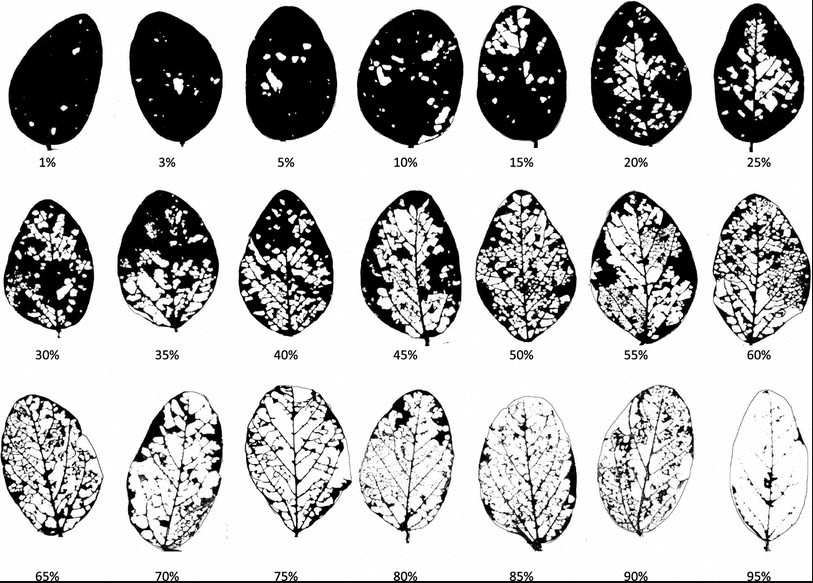In order to prevent crop damage from insects and diseases, it is essential that crops be inspected regularly. These inspections should be done regularly and could be done in conjunction with inspections for weed densities and crop nutrients and water status.
Crop monitoring indicates the pest’s status and the extent of the crop disease. In this way, the crop producer remains informed of the health status of his crop. Information on the crop disease and pest status enables the farmer to make decisions on whether control actions need to be taken and select a suitable control action. In this way, the farmer can e.g. treat crops chemically as and when required instead of according to a strict spraying programme. In this way, the amount of pesticide applied, and labour inputs can be reduced, also reducing the crop production costs.
The monitoring process is generally known as scouting. Scouting is used to identify pest species present as well as the extent of infestation of the pest. This can also be applied to crop diseases. In the case of crop diseases, it is not always possible to identify a disease or revere it to an expert in diseases. Thus, when monitoring for crop disease, the scouting process is aimed at identifying symptoms of disease, rather than collecting, identifying and counting individual pests. Plant samples can be collected for identification by experts.
Pest control programmes are based on infestation thresholds as well as economic thresholds for pest control. This programme must also take into account the growth stages of the crop plant and relate this to pest infestation rates. This aids in evaluating the vulnerability of the crop and the potential for damage that exists. The occurrence of natural pest enemies and pathogens must also be taken into account in the monitoring process.
Click here to view a video that explains citrus pest monitoring in citrus.
The monitoring process starts with surveys. Monitoring techniques exist to aid in crop surveys.

The two most useful survey techniques: are the transect and stepwise method, scouting or placement of traps. Both techniques require the investigator to walk through a field and at set intervals he stops, sampling, scouting or counting the area. Where scouting is done for diseases, the monitor should collect leaf, shoot, bud and fruit samples for identification by experts. Where the presence of diseases is suspected, samples must be collected and sent for analysis and identification by an expert.

The transect method involves scouting along a line across a field. The line can be diagonal across the field or parallel to the side of the field.
Using the transect method; a minimum of five sampling points per hectare should be selected.
When using the stepwise scouting method, the scout starts in the middle of one side of the field.
The scout moves forward and to his right stopping at pre-determined distances. Once he has crossed the whole field, the scout moves to the point of origin and repeats the exercise, but now moving forward and to his left. A maximum distance of 5 m should be used as a pre-set distance.
Once samples of insects or diseased plant parts have been collected the insects and diseases are identified. Counts of the number of pests are done to determine infestation rates. Based on the identity of the pest and the degree of infestations, taking into account the crop- and environmental information, a management strategy can be implemented.
At the pre-determined intervals, using any of the scouting methods, sampling techniques for insect collection can be used. Sampling techniques generally used in pest monitoring are explained below:
Shake and beat method: place plastic sheeting under the plants, then either shake or beat the plants with a stick and collect the insects which fall on the sheeting.
Knock-down sampling: an insecticide is applied to a small area within the target area, which kills all insects present. Similarly, to the shake and beat method, insects are collected on a pre-set plastic sheet.
Baits containing insecticides: can be used to attract and sample insects. The insecticide in laced molasses is an example.
Mites can be sampled by brushing the crop leaves onto a glass sheet. Alternatively, the mites can be brushed onto paper, the paper flattened and the stains on the paper counted.
Sweep nets are used to sample flying insects such as leaf miners. The nets, made from a suitable material, are swept across the plants, collecting the insects.
Malaise traps are used for active insects and consists of a net with an opening on one side. (Looks like a tent) A container for trapping the insects is placed at the highest end.
Sticky traps are made from strips covered with sticky substances on the surface. The sticky trap can be baited to attract certain species. The trapping efficacy of these types of traps is influenced by environmental conditions and the positioning of the trap.
Water traps are suitable containers, containing water to which a soapy substance and a preservative is added, erected 1 m above soil level. The traps are suitable especially for trapping aphids.
Sucking traps are basically modified vacuum apparatus, which sucks the insects into a net.
A light trap is a lamp, usually ultraviolet, surrounded by a vertical baffle at the top of a funnel-shaped container, and a sampling container at the bottom.
Pheromone traps are used for moths and butterflies. Pheromones (sexual hormones) of the targeted species are placed in a suitable container. The traps are set up over a large area and are suitable for monitoring populations and also for pesticide application timing.
Pitfall traps are containers, with a small volume of preservatives, which is placed into the soil so that the open end is level with the soil surface. These traps are effective for insects that live on the soil surface.
Soil Sampling
Soil sampling for soil-dwelling insects can be done by using an auger soil coring device or a blade sampler. It is important that the volume of soil is known so that the infestation per volume can be calculated.
Monitoring And Interpretation Of Pest
Scouting
Monitoring for pests is commonly known as scouting. Scouting is aimed at identifying any pests, such as insects or signs of disease, present and assessing the potential of the insect or disease becoming a problem and estimating the extent of the damage. Because different pests occur throughout the life of the crop (some pests destroy seeds, other destroys leaves and other destroys fruit), weekly inspections are recommended.
Scouting should occur before any control treatment is applied and again after treatment. This will indicate the impact of the treatment on the problem.
Pests such as grasshoppers can be observed, and their population size is estimated by walking slowly through the field and making careful observations. Others, like fungal infections, or small insect-like trips may require the use of a hand lens for observation. Monitoring for certain pests may require the use of specialized equipment or techniques such as nets or traps.
A large round net with a long handle can be used to sample flying insects on a crop. Walking along crop rows and swinging the net above the top of the crop will allow the capturing of flying crop-damaging insects. Insects can be collected at the bottom of the net for study and identification purposes.
Estimating Percent Leaf Damage
Impacts on crops are calculated by estimating the percent leaf damage of the affected plants. Although the figure below is for sunflower leaves, the system can be used as a guide to estimate the percentage of insect damage or percentage fungal infestation. If the picture of a leaf is used as the outline of a tree or crop plant, the system can be applied to score the extent of damage induced on a plant or tree.

The farmer will have a reasonable idea as to the extent of leaf or plant damage that the crop can tolerate. Different crops respond to different levels of damage. Therefore, it is important to have an accurate understanding of potential damage. Likewise, a certain number of insects on a crop is inevitable; an insecticide will not kill all problem insects. There will be a certain number of insects that can live on the crop that the farmer would consider an acceptable level.
Record Keeping
It is critical that all information gathered during scouting is accurately recorded. The information must be recorded before the application of the pesticide, and again after the treatment. These notes will be vital for you to be able to determine whether the crop treatment (such as pesticide application) was successful or not. Make sure that enough time is allowed for the treatment to become effective before the post-treatment monitoring is conducted.
Hygiene
The spreading of weeds, diseases and insect pests can be encouraged through poor hygiene practices on the farm. The aspects that are important include:
- Cleaning equipment such as shoes, tools, tyres and vehicles between sites or infestations.
- Close examination of nursery plants, seed, and imported soil or media to be used on the crop.
- Screening of irrigation water where weed seed contaminates surface water transported in canals and rivers or stored in lakes or ponds.
- Control of weeds and seed sources around the field or site.